外研版(2019)选择性必修第一册Unit 4 Meeting the Muse Using Language 课件(共38张PPT)
文档属性
| 名称 | 外研版(2019)选择性必修第一册Unit 4 Meeting the Muse Using Language 课件(共38张PPT) |  | |
| 格式 | pptx | ||
| 文件大小 | 8.6MB | ||
| 资源类型 | 教案 | ||
| 版本资源 | 外研版(2019) | ||
| 科目 | 英语 | ||
| 更新时间 | 2023-11-18 07:56:40 | ||
图片预览

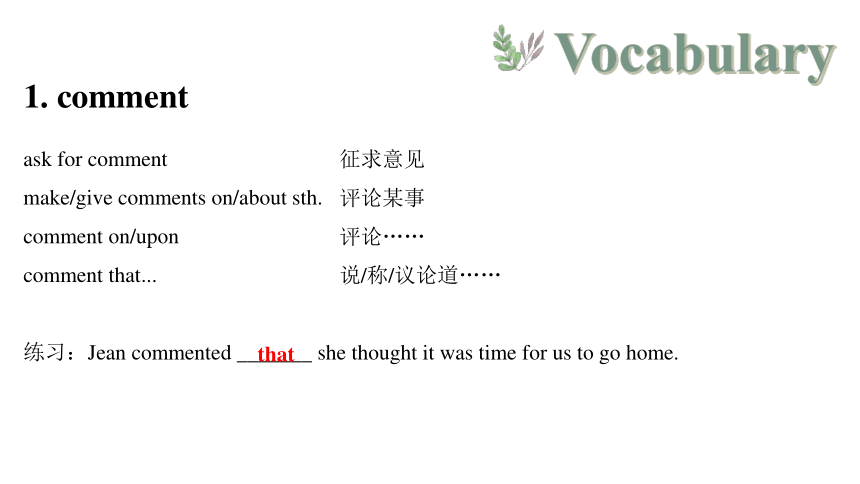
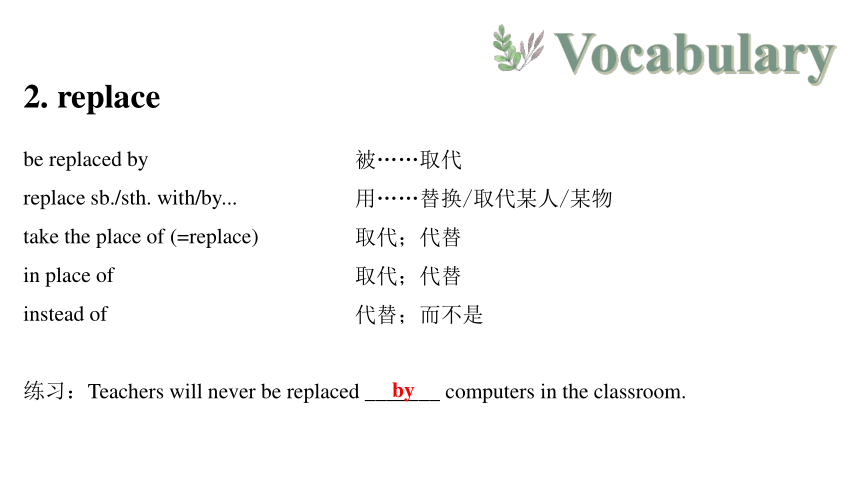
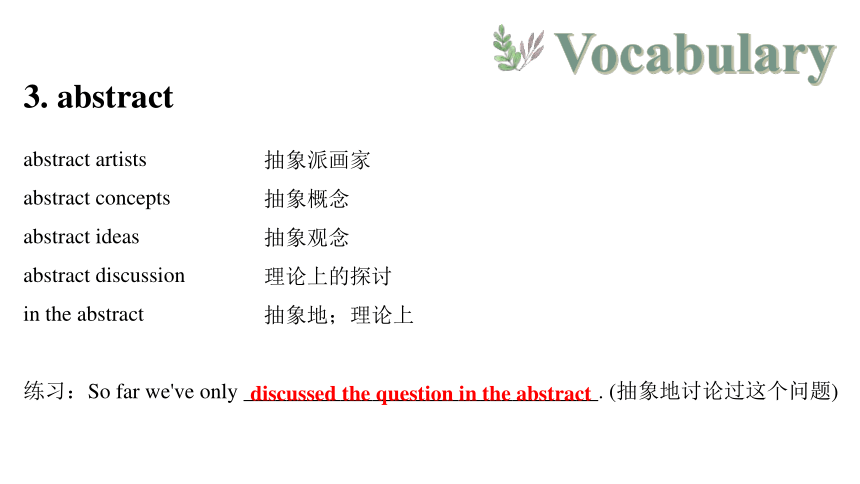
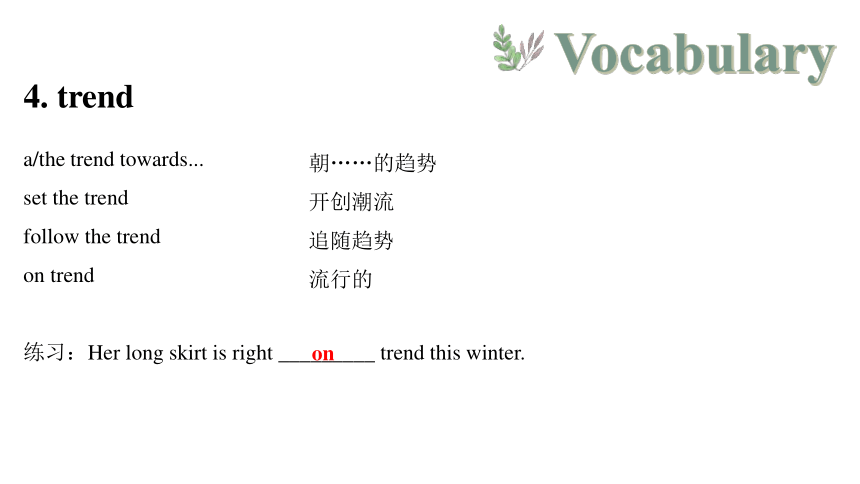

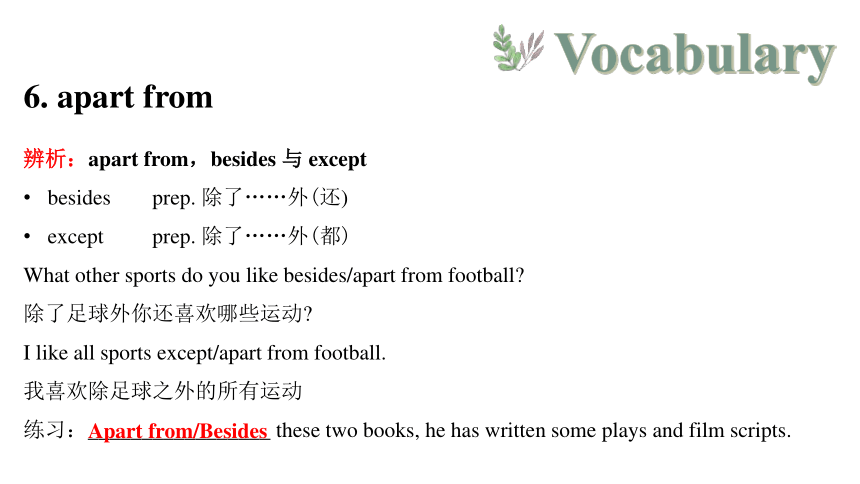
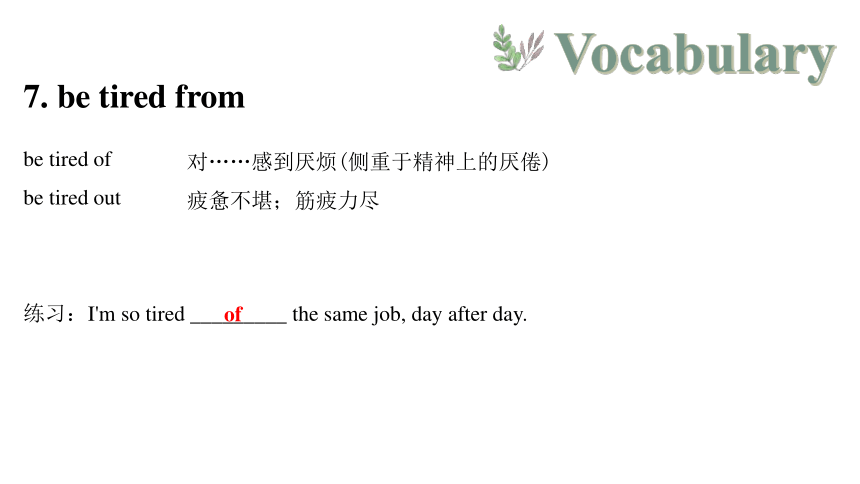
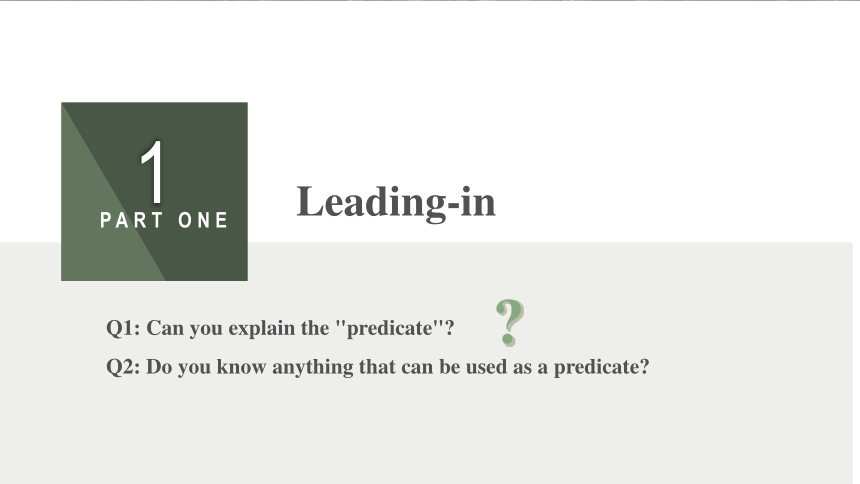
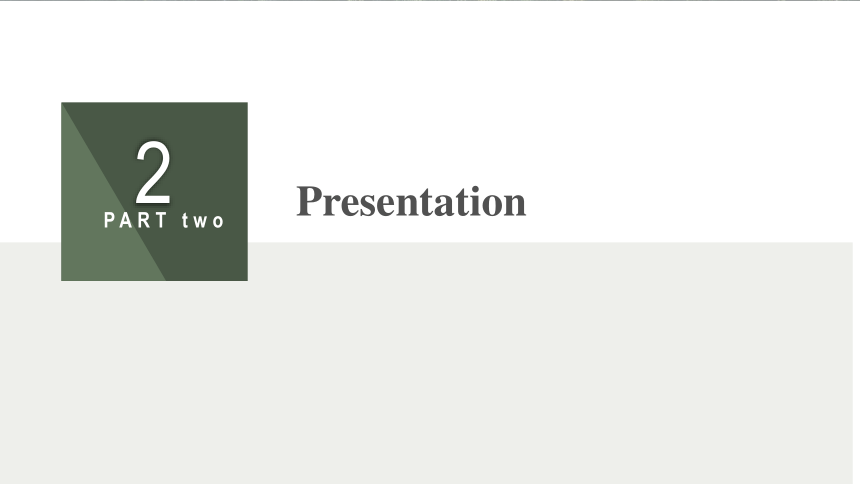
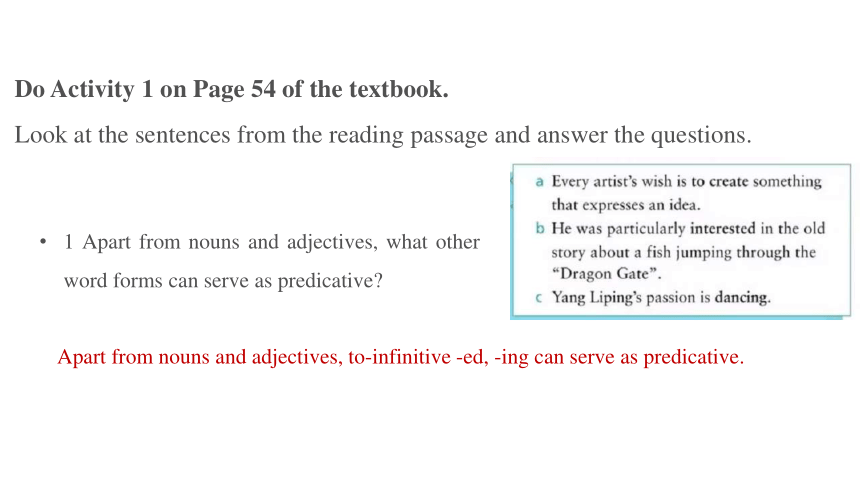
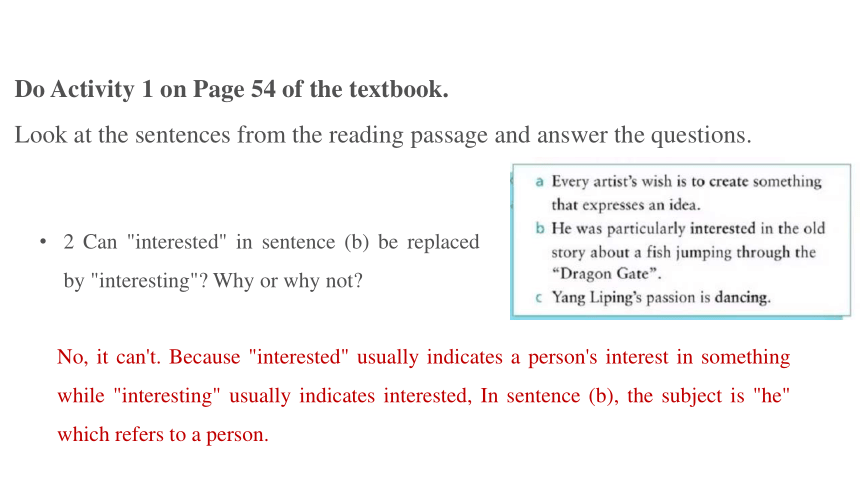
文档简介
(共38张PPT)
Unit 4 Meeting the Muse
Using Language
1. comment
ask for comment
make/give comments on/about sth.
comment on/upon
comment that...
练习:Jean commented _______ she thought it was time for us to go home.
Vocabulary
that
征求意见
评论某事
评论……
说/称/议论道……
2. replace
be replaced by
replace sb./sth. with/by...
take the place of (=replace)
in place of
instead of
练习:Teachers will never be replaced _______ computers in the classroom.
Vocabulary
by
被……取代
用……替换/取代某人/某物
取代;代替
取代;代替
代替;而不是
3. abstract
abstract artists
abstract concepts
abstract ideas
abstract discussion
in the abstract
练习:So far we've only _________________________________. (抽象地讨论过这个问题)
Vocabulary
discussed the question in the abstract
抽象派画家
抽象概念
抽象观念
理论上的探讨
抽象地;理论上
4. trend
a/the trend towards...
set the trend
follow the trend
on trend
练习:Her long skirt is right _________ trend this winter.
Vocabulary
on
朝……的趋势
开创潮流
追随趋势
流行的
5. contrast
in contrast to/with
by contrast
contrast with
contrast...with...
练习:The snow was icy and white ___________ (contrast) with the brilliant blue sky.
Vocabulary
与……形成对比
相比之下
与……形成对比
把……与……进行对比
contrasting
6. apart from
辨析:apart from,besides 与 except
besides prep. 除了……外(还)
except prep. 除了……外(都)
What other sports do you like besides/apart from football
除了足球外你还喜欢哪些运动
I like all sports except/apart from football.
我喜欢除足球之外的所有运动
练习:_________________ these two books, he has written some plays and film scripts.
Vocabulary
Apart from/Besides
7. be tired from
be tired of
be tired out
练习:I'm so tired _________ the same job, day after day.
Vocabulary
对……感到厌烦(侧重于精神上的厌倦)
疲惫不堪;筋疲力尽
of
1
PART ONE
Leading-in
Q1: Can you explain the "predicate"
Q2: Do you know anything that can be used as a predicate
2
PART two
Presentation
Do Activity 1 on Page 54 of the textbook.
Look at the sentences from the reading passage and answer the questions.
1 Apart from nouns and adjectives, what other word forms can serve as predicative
Apart from nouns and adjectives, to-infinitive -ed, -ing can serve as predicative.
Do Activity 1 on Page 54 of the textbook.
Look at the sentences from the reading passage and answer the questions.
2 Can "interested" in sentence (b) be replaced by "interesting" Why or why not
No, it can't. Because "interested" usually indicates a person's interest in something while "interesting" usually indicates interested, In sentence (b), the subject is "he" which refers to a person.
2
PART two
Now look for more sentences with these structures in the reading passage, and summarise their uses in your own words.
Do Activity 2 on Page 54 of the textbook.
Read the passage and underline the predicatives.
One of my biggest dreams had always been to see the painting Girl with a Pearl Earring, by the Dutch artist, Vermeer. It wasn't until we went on a trip to The Hague last year that this dream came true! There were lots of people waiting to enter the Mauritshuis. Although my legs were tired from walking around the city, I was determined to see the painting, which is often called the “Mona Lisa of the North”. Nobody is sure of the identity of the girl in it. And there she was. It was amazing to be standing in front of her at last! The girl is looking over her shoulder. Her eyes are wide and her mouth is parted, just as if she were about to speak. I would love to know what she was going to say!
Look at the following sentences.
His wish was to become an artist.
Her hobby is collecting stamps.
The lake is badly polluted.
Climbing is tiring and we are completely tired after a day's climbing.
What can you find
to-infinitive, -ing and -ed as predicative动词的不定式、ing和-ed 形式作表语
概述:
动词的不定式 (to do) 动词-ing 形式和-ed 形式在句中都可用作表语。
用法:
①动词的不定式作表语 ②动词的-ing形式作表语 ③动词的-ed形式作表语
区分:
① 动词的不定式和动词的-ing形式作表语的区别
② 动词的-ing 和-ed 形式作表语的区别
③ 动词的不定式作表语和不定式表示将来时的区别
④ 动词的-ing形式(动名词/现在分词)作表语和用于进行时的区别
⑤ 动词的-ed形式作表语和用于被动语态的区别
动词的不定式作表语
动词的语可以说明主语的具体内容,也可表示将来的动作。在表示“目的,愿望不定式作表,梦想,需求”等的名词作主语时其表语应该用不定式。
Our aim is to help them, not to teach them a lesson.
我们的目的是帮助他们,而不是教训他们。
(当动词的不定式用作表语时,其中的 to原则上是不能省略的。但也有特殊情况,当主语部分有动词 do的某种形式时,用作表语的不定式可以省略 to。)
What you have to do is fill in the form.
你要做的是填好这份表格。
用法
动词的-ing 形式作表语
动词的-ing 形式作表语用来说明主语的内容。一般用来表示主语的某种性质和状态,当与主语是同一概念的时候,主语与表语的位置可以互换。此外,还要注意主语与表语的一致性。
My job is teaching. 我的工作是教书。
(一般来说,表示比较抽象、一般的行为时多用动词的-ing形式作表语;表示具体某次动作,特别是将来的动作时,多用不定式作表语。有时两者都可以用,没有什么差别。)
What she likes is watching the children play.=What she likes is to watch the children play.
她喜欢的是看孩子们玩。
用法
动词的-ed 形式作表语
过去分词作表语时,总是在系动词 be appear、look remain、feelget 等之后,构成系表结构,表示主语所处状态或感受,主语多为人。分词所表示的动作与句子的主语构成动宾结构关系。
The novel is well written. 这部小说写得很好。
(动词的-ed 形式作表语与被动语态的区别:动的-ed 形式作表语表示主语的状态,而被动语态则表示主语所承受的动作。)
This lake is badly polluted. (动词的-ed形式)
这个湖受到了严重的污染。
用法
动词的不定式和动词的-ing 形式作表语的区别
动词的不定式作表语强调的是一次性、具体的、将要发生的动作;动词的-ing形式作表语强调的是一般性抽象的、经常发生的动作。
His job is to paint the walls.
他的工作是粉刷这些墙。
(一次性的,具体的,目前做的事情,并不是他日常的工作)
His job is painting walls.
他的工作是粉刷墙。(这是他日常的工作)
区分
动词的-ing 和-ed 形式作表语的区别
-ing形式说目主语的特征,-ed形式说明主语的状态。
This cat is frightening.
这只猫让人害怕。(说明猫的特征)
This cat is frightened.
这只猫有些害怕。(说明猫的状态)
区分
动词的不定式作表语和不定式表示将来时的区别
不定式作表语用于说明主语“是什么”,和主语之间是可以画等号的,不定式用来表示将来时态时,表示主语即将要执行的动作,和主语之间是不能画等号的。
What he wanted to suggest is to cut down the price and increase the sales.
他想建议的是降低价格、增加产量。
My American teacher is to leave China soon.
我的美国老师即将离开中国。
区分
动词的-ing 形式(动名词/现在分词)作表语和用于进行时的区别
动名词作表语说明主语“是什么”,现在分词作表语说明主语的特征。动词的-ing形式用于正在进行时时,说明主语正在执行的动作。
Her work is taking care of the children.
她的工作是照顾小孩。(说明主语“是什么”)
区分
动词的-ed 形式作表语和用于被动语态的区别
动词的-ed 形式作表语说明主语所处的状态。用于被动语态说明主语所承受的动作。
The cup is broken.
杯子碎了。(说明杯子的状态)
The cup was broken by Peter
杯子是被彼得打碎的。(说明杯子承受的动作——被打碎了)
区分
3
PART three
Practice
完成练习,及时巩固
Exercise:
1) When we heard of it, we were deeply _______ (move).
2) His teaching aim of this class is _______ (train) the students' speaking ability.
3) Their job is _______ (make) wheelchairs for disabled people.
4) What he likes is _________ (watch) TV after supper.
5) Your idea is not only innovative but also __________ (inspire).
6) Richard felt _______ with their __________ service at the hotel. (satisfy)
7) The movie was _________. Rose was greatly _______. (move)
moved
to train
making
watching
inspiring
satisfied
satisfying
moving
moved
8) 我的工作是教你们英语
My job is ____________________________.
9) 我的任务是今天下午清洁教室。
My task is ___________________ this afternoon.
10) 我的梦想是考入重点大学。
My dream is __________________________.
teaching you English
to clean the classroom
to enter a key university
Exercise:
Do Activities 3 & 4 on Page 54.
Complete the passage with the correct form of the verbs in brackets.
Suggested answers:
Known; to combine; to seek; to reflect; to express; interested; inspiring
3
PART three
Think of an artist you admire and talk about his or her inspiration and artworks using to-infinitive, -ing and -ed as predicative where appropriate.
Do Activity 5 on Page 55.
Read the comments and answer the questions. Pay attention to the compound adjectives in bold.
What is the exhibition about What artworks might you see in it
Which comment makes the greatest impression on you Give your reasons.
Do you want to go to this exhibition after reading the comments Why or why not
In English, you can create compound adjectives by joining two or more words together. You can guess the meaning of compound adjectives by looking at the individual words that make them up. You can even try creating your own compound adjectives!
Do Activity 6 on Page 56.
Match the compound adjectives in Activity 5 to their meanings. Think of other words and expressions that can express the same meanings.
Suggested answers:
Breathtaking;
well-known;
awe-inspiring;
highly-skilled;
ground-breaking;
over-priced
Work in groups and think of more compound adjectives to describe an art exhibition or an artwork.
4
PART four
Production
Do Activities 7~11 on Pages 56~57.
Read the passage and answer the questions.
a) What else do you know about Pablo Picasso and Feng Zikai
b) What other artists are famous for representing war and peace
What are their best-known artworks
Do Activities 7~11 on Pages 56~57.
Listen to the audio guide and find out the main message of each artwork.
Guernica
《格尔尼卡》
The Battlefield in Spring
《战场之春》
Listen again and complete the notes.
Suggested answers:
the attack on the town;
3.5 metres in height and almost 8 metres in width;
dead or wounded man; a more powerful effect;
in protest of;
some grass leaves;
the lifeless objects and the grass leaves;
encouragement to the Chinese people as well as his hope for peace
Complete the table with the expressions from the audio guide.
Suggested answers:
① Basic information: ...by the well-known...; It measures...; It is widely believed...
② What you see: In the centre of the painting, we can see...; Through.., I can see…
③ How you feel: Through..., I can feel...; In my opinion, this makes...; ...create a strong contrast.; I personally think...
Choose an art exhibition, or an artwork from an exhibition you like, and write about it using the words and expressions in this section.
Work in pairs. Make improvements to each other's writings and share them with the class.
Exercise:
1. She was deeply _______ (move) by the sad story, so she read it until into the night.
2. The film that he recommended to us is __________ very (interest).
3. She was _______ (satisfy) with her daughter's exam result.
4. The difference between these two words are ________ (strike).
5. What Joe wants to do seems _______ (tell) you something.
6. Mary doesn't seem _______ (like) the idea.
satisfied
interesting
moved
striking
to tell
to like
Unit 4 Meeting the Muse
Using Language
1. comment
ask for comment
make/give comments on/about sth.
comment on/upon
comment that...
练习:Jean commented _______ she thought it was time for us to go home.
Vocabulary
that
征求意见
评论某事
评论……
说/称/议论道……
2. replace
be replaced by
replace sb./sth. with/by...
take the place of (=replace)
in place of
instead of
练习:Teachers will never be replaced _______ computers in the classroom.
Vocabulary
by
被……取代
用……替换/取代某人/某物
取代;代替
取代;代替
代替;而不是
3. abstract
abstract artists
abstract concepts
abstract ideas
abstract discussion
in the abstract
练习:So far we've only _________________________________. (抽象地讨论过这个问题)
Vocabulary
discussed the question in the abstract
抽象派画家
抽象概念
抽象观念
理论上的探讨
抽象地;理论上
4. trend
a/the trend towards...
set the trend
follow the trend
on trend
练习:Her long skirt is right _________ trend this winter.
Vocabulary
on
朝……的趋势
开创潮流
追随趋势
流行的
5. contrast
in contrast to/with
by contrast
contrast with
contrast...with...
练习:The snow was icy and white ___________ (contrast) with the brilliant blue sky.
Vocabulary
与……形成对比
相比之下
与……形成对比
把……与……进行对比
contrasting
6. apart from
辨析:apart from,besides 与 except
besides prep. 除了……外(还)
except prep. 除了……外(都)
What other sports do you like besides/apart from football
除了足球外你还喜欢哪些运动
I like all sports except/apart from football.
我喜欢除足球之外的所有运动
练习:_________________ these two books, he has written some plays and film scripts.
Vocabulary
Apart from/Besides
7. be tired from
be tired of
be tired out
练习:I'm so tired _________ the same job, day after day.
Vocabulary
对……感到厌烦(侧重于精神上的厌倦)
疲惫不堪;筋疲力尽
of
1
PART ONE
Leading-in
Q1: Can you explain the "predicate"
Q2: Do you know anything that can be used as a predicate
2
PART two
Presentation
Do Activity 1 on Page 54 of the textbook.
Look at the sentences from the reading passage and answer the questions.
1 Apart from nouns and adjectives, what other word forms can serve as predicative
Apart from nouns and adjectives, to-infinitive -ed, -ing can serve as predicative.
Do Activity 1 on Page 54 of the textbook.
Look at the sentences from the reading passage and answer the questions.
2 Can "interested" in sentence (b) be replaced by "interesting" Why or why not
No, it can't. Because "interested" usually indicates a person's interest in something while "interesting" usually indicates interested, In sentence (b), the subject is "he" which refers to a person.
2
PART two
Now look for more sentences with these structures in the reading passage, and summarise their uses in your own words.
Do Activity 2 on Page 54 of the textbook.
Read the passage and underline the predicatives.
One of my biggest dreams had always been to see the painting Girl with a Pearl Earring, by the Dutch artist, Vermeer. It wasn't until we went on a trip to The Hague last year that this dream came true! There were lots of people waiting to enter the Mauritshuis. Although my legs were tired from walking around the city, I was determined to see the painting, which is often called the “Mona Lisa of the North”. Nobody is sure of the identity of the girl in it. And there she was. It was amazing to be standing in front of her at last! The girl is looking over her shoulder. Her eyes are wide and her mouth is parted, just as if she were about to speak. I would love to know what she was going to say!
Look at the following sentences.
His wish was to become an artist.
Her hobby is collecting stamps.
The lake is badly polluted.
Climbing is tiring and we are completely tired after a day's climbing.
What can you find
to-infinitive, -ing and -ed as predicative动词的不定式、ing和-ed 形式作表语
概述:
动词的不定式 (to do) 动词-ing 形式和-ed 形式在句中都可用作表语。
用法:
①动词的不定式作表语 ②动词的-ing形式作表语 ③动词的-ed形式作表语
区分:
① 动词的不定式和动词的-ing形式作表语的区别
② 动词的-ing 和-ed 形式作表语的区别
③ 动词的不定式作表语和不定式表示将来时的区别
④ 动词的-ing形式(动名词/现在分词)作表语和用于进行时的区别
⑤ 动词的-ed形式作表语和用于被动语态的区别
动词的不定式作表语
动词的语可以说明主语的具体内容,也可表示将来的动作。在表示“目的,愿望不定式作表,梦想,需求”等的名词作主语时其表语应该用不定式。
Our aim is to help them, not to teach them a lesson.
我们的目的是帮助他们,而不是教训他们。
(当动词的不定式用作表语时,其中的 to原则上是不能省略的。但也有特殊情况,当主语部分有动词 do的某种形式时,用作表语的不定式可以省略 to。)
What you have to do is fill in the form.
你要做的是填好这份表格。
用法
动词的-ing 形式作表语
动词的-ing 形式作表语用来说明主语的内容。一般用来表示主语的某种性质和状态,当与主语是同一概念的时候,主语与表语的位置可以互换。此外,还要注意主语与表语的一致性。
My job is teaching. 我的工作是教书。
(一般来说,表示比较抽象、一般的行为时多用动词的-ing形式作表语;表示具体某次动作,特别是将来的动作时,多用不定式作表语。有时两者都可以用,没有什么差别。)
What she likes is watching the children play.=What she likes is to watch the children play.
她喜欢的是看孩子们玩。
用法
动词的-ed 形式作表语
过去分词作表语时,总是在系动词 be appear、look remain、feelget 等之后,构成系表结构,表示主语所处状态或感受,主语多为人。分词所表示的动作与句子的主语构成动宾结构关系。
The novel is well written. 这部小说写得很好。
(动词的-ed 形式作表语与被动语态的区别:动的-ed 形式作表语表示主语的状态,而被动语态则表示主语所承受的动作。)
This lake is badly polluted. (动词的-ed形式)
这个湖受到了严重的污染。
用法
动词的不定式和动词的-ing 形式作表语的区别
动词的不定式作表语强调的是一次性、具体的、将要发生的动作;动词的-ing形式作表语强调的是一般性抽象的、经常发生的动作。
His job is to paint the walls.
他的工作是粉刷这些墙。
(一次性的,具体的,目前做的事情,并不是他日常的工作)
His job is painting walls.
他的工作是粉刷墙。(这是他日常的工作)
区分
动词的-ing 和-ed 形式作表语的区别
-ing形式说目主语的特征,-ed形式说明主语的状态。
This cat is frightening.
这只猫让人害怕。(说明猫的特征)
This cat is frightened.
这只猫有些害怕。(说明猫的状态)
区分
动词的不定式作表语和不定式表示将来时的区别
不定式作表语用于说明主语“是什么”,和主语之间是可以画等号的,不定式用来表示将来时态时,表示主语即将要执行的动作,和主语之间是不能画等号的。
What he wanted to suggest is to cut down the price and increase the sales.
他想建议的是降低价格、增加产量。
My American teacher is to leave China soon.
我的美国老师即将离开中国。
区分
动词的-ing 形式(动名词/现在分词)作表语和用于进行时的区别
动名词作表语说明主语“是什么”,现在分词作表语说明主语的特征。动词的-ing形式用于正在进行时时,说明主语正在执行的动作。
Her work is taking care of the children.
她的工作是照顾小孩。(说明主语“是什么”)
区分
动词的-ed 形式作表语和用于被动语态的区别
动词的-ed 形式作表语说明主语所处的状态。用于被动语态说明主语所承受的动作。
The cup is broken.
杯子碎了。(说明杯子的状态)
The cup was broken by Peter
杯子是被彼得打碎的。(说明杯子承受的动作——被打碎了)
区分
3
PART three
Practice
完成练习,及时巩固
Exercise:
1) When we heard of it, we were deeply _______ (move).
2) His teaching aim of this class is _______ (train) the students' speaking ability.
3) Their job is _______ (make) wheelchairs for disabled people.
4) What he likes is _________ (watch) TV after supper.
5) Your idea is not only innovative but also __________ (inspire).
6) Richard felt _______ with their __________ service at the hotel. (satisfy)
7) The movie was _________. Rose was greatly _______. (move)
moved
to train
making
watching
inspiring
satisfied
satisfying
moving
moved
8) 我的工作是教你们英语
My job is ____________________________.
9) 我的任务是今天下午清洁教室。
My task is ___________________ this afternoon.
10) 我的梦想是考入重点大学。
My dream is __________________________.
teaching you English
to clean the classroom
to enter a key university
Exercise:
Do Activities 3 & 4 on Page 54.
Complete the passage with the correct form of the verbs in brackets.
Suggested answers:
Known; to combine; to seek; to reflect; to express; interested; inspiring
3
PART three
Think of an artist you admire and talk about his or her inspiration and artworks using to-infinitive, -ing and -ed as predicative where appropriate.
Do Activity 5 on Page 55.
Read the comments and answer the questions. Pay attention to the compound adjectives in bold.
What is the exhibition about What artworks might you see in it
Which comment makes the greatest impression on you Give your reasons.
Do you want to go to this exhibition after reading the comments Why or why not
In English, you can create compound adjectives by joining two or more words together. You can guess the meaning of compound adjectives by looking at the individual words that make them up. You can even try creating your own compound adjectives!
Do Activity 6 on Page 56.
Match the compound adjectives in Activity 5 to their meanings. Think of other words and expressions that can express the same meanings.
Suggested answers:
Breathtaking;
well-known;
awe-inspiring;
highly-skilled;
ground-breaking;
over-priced
Work in groups and think of more compound adjectives to describe an art exhibition or an artwork.
4
PART four
Production
Do Activities 7~11 on Pages 56~57.
Read the passage and answer the questions.
a) What else do you know about Pablo Picasso and Feng Zikai
b) What other artists are famous for representing war and peace
What are their best-known artworks
Do Activities 7~11 on Pages 56~57.
Listen to the audio guide and find out the main message of each artwork.
Guernica
《格尔尼卡》
The Battlefield in Spring
《战场之春》
Listen again and complete the notes.
Suggested answers:
the attack on the town;
3.5 metres in height and almost 8 metres in width;
dead or wounded man; a more powerful effect;
in protest of;
some grass leaves;
the lifeless objects and the grass leaves;
encouragement to the Chinese people as well as his hope for peace
Complete the table with the expressions from the audio guide.
Suggested answers:
① Basic information: ...by the well-known...; It measures...; It is widely believed...
② What you see: In the centre of the painting, we can see...; Through.., I can see…
③ How you feel: Through..., I can feel...; In my opinion, this makes...; ...create a strong contrast.; I personally think...
Choose an art exhibition, or an artwork from an exhibition you like, and write about it using the words and expressions in this section.
Work in pairs. Make improvements to each other's writings and share them with the class.
Exercise:
1. She was deeply _______ (move) by the sad story, so she read it until into the night.
2. The film that he recommended to us is __________ very (interest).
3. She was _______ (satisfy) with her daughter's exam result.
4. The difference between these two words are ________ (strike).
5. What Joe wants to do seems _______ (tell) you something.
6. Mary doesn't seem _______ (like) the idea.
satisfied
interesting
moved
striking
to tell
to like
